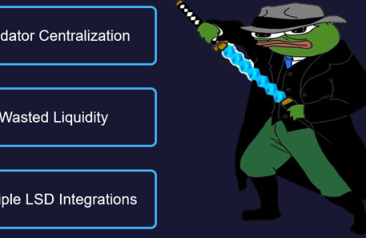Anchor Protocol Update - Dynamic Earn Rate
Anchor Introduces Update to Earn Rate Calculation
Two issues ago, I wrote about Anchor Protocol, a dynamic savings platform that leverages money market demand and diversified staking rewards to pay out attractive stablecoin yields.
Much has developed since – as they say, one week in the depths of DeFi feels like one year in real life.
Acknowledging how the macro environment has affected its micro mechanics, Anchor Protocol garnered enough support on March 24th to pass Poll #20, in which a Terra protocol researcher suggested the following changes to the Anchor Earn Rate:
% Earn Rate Change = min (abs (1.5%, ((YR % Change)), where
- YR = Yield Reserve
Effectively, this change allows Anchor to adjust the monthly yield payout to UST depositors in proportion to the monthly rate of increase or decrease of the Yield Reserve balance.
The Anchor Earn Rate can be adjusted by a maximum of +1.5% in either direction. For example, if the Yield Reserve increases by 10%, the Anchor Earn Rate increases by 1.5%. If the Yield Reserve decreases by 0.5%, the Anchor Earn Rate can be adjusted by a maximum of -1.5% and -0.5%. Here, Anchor Earn Rate reduces by 0.5%.
Updating Our Model
Given this material protocol update, I have expanded on the model from our Anchor introductory issue to account for these changes and introduced other moving parts to more precisely define the variables affecting the Anchor Run Rate, including these assumptions:
- Firstly, I’ve introduced the dynamic earn rate according to the previous periods’ change in yield reserve balance.
- Due to the sheer size of UST borrowed, however, the Anchor Earn rate will consistently reduce by 1.5% per month until the Yield Reserve gets depleted.
- I also assume bETH and bLUNA collateral growth starting at 25.0% (Oct’ 21 – Mar’ 21 growth rates stood at 23.5%), with growth rates adjusted downward by a factor of 0.80 from month to month.
- Because wasAVAX is a new collateral addition, I assume growth starts at 90% and is adjusted downward by a factor of 0.90 month to month. These assumptions project $15.3b, $5.0b, and $3.4b in bLUNA, bETH, and wasAVAX collateral respectively for Mar’ 23.
- These are probably the most fluid assumptions in the model and are subject to change quite frequently. However, this provides us with a proper framework to estimate collateral runway.
- I assume the same conservative growth assumptions for Anchor Earn deposits, starting at 25% (March growth rates were 45.5%) and adjusted downward by a factor of 0.8, resulting in $20b UST deposited by early June. The model also assumes staking rewards remain unchanged throughout the projection year (neglecting Ethereum 2.0’s projected post-merge surge in staking yields).
To understand the relative impact of each variable in the model above, we can again sensitize the Anchor Earn deposits and collateral growth inputs below.

Unsurprisingly, the takeaways are not dissimilar to my previous point-in-time analysis. As it stands, Anchor has 80 days of run rate assuming bETH and bLUNA grow at 85% from their end March collateral balances, and Anchor Earn deposits grow at 67.5%. These are fairly aggressive for estimating the run rate (giving Do the benefit of the doubt), given that Earndeposits have grown by 45.5% in March.
Since writing, Anchor emissions that subsidize bETH and bLUNA collateralized UST borrowings have also dropped – seekers of leverage are currently paying a net 4.43% APR. The strategic thinking behind this move eludes me, as lesser emissions translate to more expensive (and less) borrowing, which results in less interest used to subsidize the Anchor Earn Rate.
The preliminary takeaways here are that:
- increasing collateral growth is helpful in closing the gap between the sources and uses of the Anchor Protocol, but slowing deposits has a greater relative effect, and
- regardless of actions taken, the sensitivity ranges presented above would only result in at 43 days of the incremental runway at maximum
Bolstering the Peg by Purchasing BTC using Luna Foundation Guard (LFG)
In addition to reducing the Anchor Earn Rate, Do Kwon and his investors have been working hard at restoring users’ confidence in the Terra ecosystem.
One high-profile initiative includes LFG’s purchases of BTC detailed in last week’s Crypto Weekly, in which Sean wrote extensively about the effects of these purchases on spot price.
The $1.3b bitcoin (out of $3b) purchased is currently held in LFG’s wallet. LFG has indicated that the reserve created through the $3 billion capital injection will effectively act as a “release valve” for UST redemptions; it is designed to ensure that the price of the stablecoin remains pegged to that of the dollar during sharp selloffs in crypto markets.
The introduction of LFG’s BTC reserve should temporarily appease concerns from investors (as the market has indicated with LUNA and BTC rallying) in the broader Terra ecosystem in the short term, but potentially introduces other vectors of risk.
By enabling redemption of UST for BTC instead of LUNA, BTC might see additional liquidity flowing into exchanges from the Terra ecosystem during market distress. Nevertheless, this new redemption mechanism is in aggregate safer (than without it), albeit at the cost of the broader crypto ecosystem.
… And Leveraging DeFi 1.0 Giants…
Additionally, Terra plans to deploy a permissionless pool on Curve called 4pool, consisting of UST, FRAX, USDC, and USDT. The 4pool will be tested on Fantom and Arbitrum before launching on the Ethereum mainnet once some Curve infrastructure is enabled.
Through a partnership with FRAX, the 4pool will realize Convex (CVX) and Curve (CRV) synergies by leveraging Votium (delegated voting power protocol) incentives. Additionally, 4pool enables UST to become a collateral asset for the partially backed stablecoin FRAX (apart from FXS).
By doing this, Do has also hinted at intentions to ‘starve’ the 3pool, comprised of DAI, USDC, and USDT. For context, DAI, the overcollateralized stablecoin from MakerDAO, has long been a rival of UST and Terra. To this point, Do frequently states that ‘Decentralized economies need decentralized money’, alluding to the need for UST over its centralized competitor, DAI.
Should this vampire attack succeed, it will be a huge win for both leading algorithmic stablecoins FRAX and UST, which we will cover in-depth in a future issue.
… And Recruiting the Help of Degens
Leveraging Protocol-Owned-Liquidity mechanics first popularized by OlympusDAO, Redacted Cartel is a layer on top gauges (like Curve Finance) with the mandate of accumulating control over the CRV, CVX, FXS, TOKE, and gOHM ecosystems. Its treasury boasts over $100m in governance tokens, and has developed plans with Terra to leverage it symbiotically.
Firstly, the Terra will leverage Redacted Cartel’s Hidden Hand, a generalized incentive market protocol for veTokens to secure a Tokemak Reactor. With the Hidden Hand marketplace, protocols will be able to create markets for their ve-tokens while Redacted captures a fee that is redistributed to lockers of BTRFLY.
Secondly, debtDAO will issue its first UST-denominated loan to Redacted Cartel, piloting the decentralized debt marketplace catering to other protocols.
Last but certainly not least, Terra will be leveraging Redacted Cartel’s influence over Curve and Convex.
For those unfamiliar, Curve Finance is an automated market maker which specializes in stablecoins swap with low price slippage. As covered in a previous issue of DeFi Digest, liquidity providers deposit stablecoins into a pool to earn trading fees. The governance token, CRV, can be locked for a period of 1 to 4 years at 0.25 to 1 conversion rate for veCRV.
This vote-escrowed CRV (veCRV) that represents locked CRV tokens then allows liquidity providers to earn boosted rewards for their liquidity pools. For example, vote-locking CRV for 1 year gives you 0.25 veCRV, which can boost rewards by a factor of 0.8. Holders of veCRV can either vote to direct CRV rewards towards their desired LP pool or receive ‘bribes’ from other protocols to direct votes to them.
Sitting on top of the Curve ecosystem, Convex Finance is another project that attempts to capture the governance power over CRV emissions. Currently, 43% of veCRV is held by Convex as vote-locked (vlCVX), signaling that Curve wars have already found a winner.
As such, the power struggle shift towards Convex – whoever controls Convex has influence over Curve. In comes the Redacted Cartel.
Being the third largest DAO holder of CVX, Redacted Cartel will vote for the 4pool (UST+3CRV) and claim UST votium incentives. Redacted has also agreed not to sell UST for other stablecoins and will use it to pay contributors, partake in seed deals, partake in single-sided LPs, and build their treasury.
This partnership appears to be mutually beneficial as Redacted can solely receive a single stablecoin (UST) instead of multiple tokens from Votium that are not necessarily aligned with their mission. Terra, on the other hand, introduces another source of yield for UST (apart from Anchor) and bolsters broader adoption for UST in DeFi.
Bottom Line
Through the Redacted Cartel and Frax initiatives, Do Kwon attempts to ease the pressure on Luna and the Anchor Yield Reserve from the public lens, but the numbers don’t lie – despite the proposed changes to the protocol, and apparent new use cases for UST, Anchor yields cannot sustain at these rates for much longer without significant changes to the model. When yields compress, market participants will at best leave for greener pastures in the 4pool or at worst stablecoin farms elsewhere.
While it is tough to estimate the aggregate effects on UST from Terra’s initiatives and the rate at which Anchor’s Yield Reserve is depleting, one cannot help but wonder: “Anon, 73% of UST is currently deposited in Anchor. Will Terra be able to support demand for UST before Anchor Yield Reserve depletes? If not, what happens to LUNA price?”
It is all too easy to paint a picture of gloom for Anchor, Luna, and UST based on the commentary above. Nonetheless, I can imagine a world in which UST succeeds as the first widely-adopted decentralized algorithmic stablecoin (and LUNA price continues its surge up).
Regardless of what happens in the ensuing months, one thing is for sure – Do has proved himself to be an exceptional community and narrative builder, deserving of the success Terra has had so far.
If the race to facilitate organic demand for UST started one year ago on Anchor’s birthday, it surely feels like we are in the homestretch now.
Reports you may have missed
BRC-20 FEVER Ordinal transactions on Bitcoin have skyrocketed in the last few months, leading to an all-time high for daily transactions and pushing Bitcoin network fees to 2-year highs. The activity throttled BTC’s network so much that Binance was forced to temporarily shut down withdrawals and implement Lightening Network to service outflows without paying excessive fees. There are currently two types of Ordinal transactions on the network: 1) Ordinal NFTs...
FIGURE: PEPES WEARING CONES TO CELEBRATE NEW CURVE ECOSYSTEM PROTOCOL INVESTMENT THESIS Out of the numerous tokenomic designs that emerged (and failed) last cycle, the vote-escrowed model proved objectively most ‘feasible’, as evidenced by Curve’s dominant position in TVL amongst DEXs. Control over a protocol’s gauge emissions made sense to many, assigning real value to governance tokens. The second-order expectations that liquidity would follow did as well. However, maximizing yield...
FIGURE: PEPE UNSHETH-ING ITS ETH TO SOLVE MULTIPLE DEFI PAINPOINTS Since the Beacon Chain launch in Dec 2020, Ethereum users could stake bundles of 32 ETH to secure the network in exchange for priority fee rewards. While these staked ETH[1] are ‘productive,’ many have opted against staking given its operational complexity and illiquidity. Liquid staking projects solve for this by managing validator uptime and offering liquid staking derivatives (LSDs) to...
FIGURE: PEPE LEARNING ABOUT GHO AFTER BEING RUGGED BY UST Source: Fundstrat INTRODUCTION Founded by Stani Kuchelov, Aave (formerly LEND) is the largest DeFi lending market by TVL (~$8b across v2 and v3) and the fifth largest dApp overall. The protocol is currently live across five networks and 11 markets, hosting more than 30 assets across its platform. In July ‘22, Aave announced that they are launching their native stablecoin,...


















